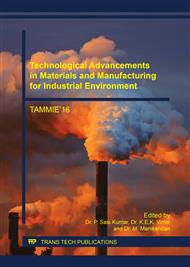[1]
G. Santhanakrishnan, R. Krishnamurthy and S.K. Malhotra, Machinability characteristics of fibre reinforced plastic composites. J Mech work Technol, 17 (1988) 195-204.
DOI: 10.1016/0378-3804(88)90021-6
Google Scholar
[2]
G. Taguchi, Introduction to quality engineering, Asian Productivity Organization, Eighth printing., Tokyo, (1990).
Google Scholar
[3]
W. Konig, CronjagerL, G. Spur, H.K. Tonshoff, M. Vigneau and W. Zdeblick, J. Machining of new materials, CIRP Annals-Manuf Technol, 39 (1990) 673-681.
DOI: 10.1016/s0007-8506(07)63004-2
Google Scholar
[4]
J.I. Lin, K.S. Wang, B. H, Yan and Y.S. Tarng, Optimization of the electrical discharge machining process based on the Taguchi method with fuzzy logics. J Mats Processing Technol, 102 (2000) 48–55.
DOI: 10.1016/s0924-0136(00)00438-6
Google Scholar
[5]
C. Dhavamani and T. Alwarsamy, Review on optimization of machining operation. Int J Academic Research, 3 (2011) 476-485.
Google Scholar
[6]
W. Konig, WulfCh, P. Grab and H. Willerscheid, Machining of fibre reinforced plastics, CIRP, Annals –Manuf Technol, 34 (1985) 537-548.
DOI: 10.1016/s0007-8506(07)60186-3
Google Scholar
[7]
A. Naveen sait, S. Aravindan and A. Noorul Hag, Optimization of machining parameters of glass-fibre-reinforced plastic (GFRP) pipes by desirability function analysis using Taguchi technique. The Int J Adv Manuf Technol, 43 (2009) 581-589.
DOI: 10.1007/s00170-008-1731-y
Google Scholar
[8]
K. Palanikumar, L. Karunamoorthy and R. Karthikeyan, Multiple performance optimization of machining parameters on the machining of GFRP composites using carbide (K10) tool, J Mat and Manuf Processes, 21 (2006) 846-852.
DOI: 10.1080/03602550600728166
Google Scholar
[9]
R. Venkata Rao and V.D. Kalyankar, Parameter optimization of machining processes using a new optimization algorithm. J Mat and Manuf Processes, 27 (2012) 978-985.
DOI: 10.1080/10426914.2011.602792
Google Scholar
[10]
K. Palanikumar, Application of Taguchi and response surface methodologies for surface roughness in machining glass fibre reinforced plastics by PCD tooling, Int J Adv Manuf Technol, 36 (2008) 19-27.
DOI: 10.1007/s00170-006-0811-0
Google Scholar
[11]
N. Muthukrishnan and J. Paulo Davim, Optimization of machining parameters of AI/SiC-MMC with ANOVA and ANN analysis, J Mats Processing Technol, 209 (2009) 225-232.
DOI: 10.1016/j.jmatprotec.2008.01.041
Google Scholar
[12]
K. Palanikumar, L. Karunamoorthy, R. Karthikeyan and B. Latha, Optimization of machining parameters in turning of GFRP composites using a carbide (K10) tool based on the Taguchi method with fuzzy logics. J Metals and Materials International, 12 (2006).
DOI: 10.1007/bf03027748
Google Scholar
[13]
Kamal Hassan, Anish Kumar, and M.P. Garg, Experimental investigation of material removal rate in CNC turning using Taguchi method, Int J Engg Research and Applications, (2012) 1581-1590.
Google Scholar
[14]
K. Palanikumar, Cutting parameters optimization for surface roughness in machining of GFRP composites using Taguchi's method. J Reinforced Plastics and Composites, 25 (2006) 1739-1751.
DOI: 10.1177/0731684406068445
Google Scholar
[15]
Syed Altafhussain, V. Pandurangan and K. Palani Kumar, Machinability of glass fiber reinforced plastic (GFRP) composte materials. Int J Engg science and Technol, 3 (2011) 103-118.
Google Scholar
[16]
P. Sam Paul and A.S. Varadarajan, A multi-sensor fusion model based on an artificial neural network to predict tool wear during hard turning, Proc. IMechE Part B, J Engg Manuf, 226 (2012) 853-860.
DOI: 10.1177/0954405411432381
Google Scholar
[17]
Razfar and Zanjani Zadeh, Optimum damage and surface roughness prediction in end milling glass fibre-reinforced plastics, using neural network and genetic algorithm, Proc Institution of the Mech Engineers, Part B: J Engg Manuf, 223 (2009).
DOI: 10.1243/09544054jem1409
Google Scholar
[18]
P.J. Ross, Taguchi techniques for quality engineering, loss function, orthogonal experiments, parameter and tolerance design. Second ed., New York, (1996).
Google Scholar
[19]
Serope Kalpakjian and R. Stevan Schmid, Manuf Engineering and Technol. Fourth ed., Pearson Education Inc, New Delhi, India, (2012).
Google Scholar
[20]
Vinod Kumar Venkanti and Venkateswarlu Ganta, Optimization of process parameters in drilling of GFRP composites using Taguchi method, J Mater Res Technol, 3 (2014) 34-41.
Google Scholar


